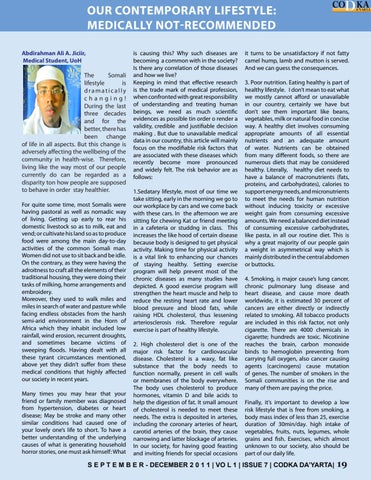OUR CONTEMPORARY LIFESTYLE: MEDICALLY NOT-RECOMMENDED Abdirahman Ali A. Jiciir, Medical Student, UoH
The Somali lifestyle is dramatically changing! During the last three decades and for the better, there has been change of life in all aspects. But this change is adversely affecting the wellbeing of the community in health-wise. Therefore, living like the way most of our people currently do can be regarded as a disparity ton how people are supposed to behave in order stay healthier. For quite some time, most Somalis were having pastoral as well as nomadic way of living. Getting up early to rear his domestic livestock so as to milk, eat and vend; or cultivate his land so as to produce food were among the main day-to-day activities of the common Somali man. Women did not use to sit back and be idle. On the contrary, as they were having the adroitness to craft all the elements of their traditional housing, they were doing their tasks of milking, home arrangements and embroidery. Moreover, they used to walk miles and miles in search of water and pasture while facing endless obstacles from the harsh semi-arid environment in the Horn of Africa which they inhabit included low rainfall, wind erosion, recurrent droughts, and sometimes became victims of sweeping floods. Having dealt with all these tyrant circumstances mentioned, above yet they didn’t suffer from these medical conditions that highly affected our society in recent years. Many times you may hear that your friend or family member was diagnosed from hypertension, diabetes or heart disease; May be stroke and many other similar conditions had caused one of your lovely one’s life to short. To have a better understanding of the underlying causes of what is generating household horror stories, one must ask himself: What
is causing this? Why such diseases are becoming a common with in the society? Is there any correlation of those diseases and how we live? Keeping in mind that effective research is the trade mark of medical profession, when confronted with great responsibility of understanding and treating human beings, we need as much scientific evidences as possible tin order o render a validity, credible and justifiable decision making . But due to unavailable medical data in our country, this article will mainly focus on the modifiable risk factors that are associated with these diseases which recently become more pronounced and widely felt. The risk behavior are as follows: 1.Sedatary lifestyle, most of our time we take sitting, early in the morning we go to our workplace by cars and we come back with these cars. In the afternoon we are sitting for chewing Kat or friend meeting in a cafeteria or studdng in class. This increases the like hood of certain disease because body is designed to get physical activity. Making time for physical activity is a vital link to enhancing our chances of staying healthy. Setting exercise program will help prevent most of the chronic diseases as many studies have depicted. A good exercise program will strengthen the heart muscle and help to reduce the resting heart rate and lower blood pressure and blood fats, while raising HDL cholesterol, thus lessening arteriosclerosis risk. Therefore regular exercise is part of healthy lifestyle. 2. High cholesterol diet is one of the major risk factor for cardiovascular disease. Cholesterol is a waxy, fat like substance that the body needs to function normally, present in cell walls or membranes of the body everywhere. The body uses cholesterol to produce hormones, vitamin D and bile acids to help the digestion of fat. It small amount of cholesterol is needed to meet these needs. The extra is deposited in arteries, including the coronary arteries of heart, carotid arteries of the brain, they cause narrowing and latter blockage of arteries. In our society, for having good feasting and inviting friends for special occasions
it turns to be unsatisfactory if not fatty camel hump, lamb and mutton is served. And we can guess the consequences. 3. Poor nutrition. Eating healthy is part of healthy lifestyle. I don’t mean to eat what we mostly cannot afford or unavailable in our country, certainly we have but don’t see them important like beans, vegetables, milk or natural food in concise way. A healthy diet involves consuming appropriate amounts of all essential nutrients and an adequate amount of water. Nutrients can be obtained from many different foods, so there are numerous diets that may be considered healthy. Literally, healthy diet needs to have a balance of macronutrients (fats, proteins, and carbohydrates), calories to support energy needs, and micronutrients to meet the needs for human nutrition without inducing toxicity or excessive weight gain from consuming excessive amounts. We need a balanced diet instead of consuming excessive carbohydrates, like pasta, in all our routine diet. This is why a great majority of our people gain a weight in asymmetrical way which is mainly distributed in the central abdomen or buttocks. 4. Smoking, is major cause’s lung cancer, chronic pulmonary lung disease and heart disease, and cause more death worldwide, it is estimated 30 percent of cancers are either directly or indirectly related to smoking. All tobacco products are included in this risk factor, not only cigarette. There are 4000 chemicals in cigarette; hundreds are toxic. Nicotinine reaches the brain, carbon monoxide binds to hemoglobin preventing from carrying full oxygen, also cancer causing agents (carcinogens) cause mutation of genes. The number of smokers in the Somali communities is on the rise and many of them are paying the price. Finally, it’s important to develop a low risk lifestyle that is free from smoking, a body mass index of less than 25, exercise duration of 30min/day. high intake of vegetables, fruits, nuts, legumes, whole grains and fish. Exercises, which almost unknown to our society, also should be part of our daily life.
S E P T E M B E R - DECEMBER 2 0 1 1 | VO L 1 | ISSUE 7 | CODKA DA’YARTA|
19









